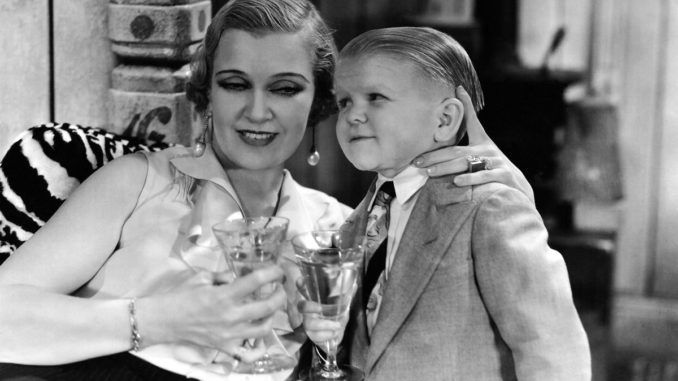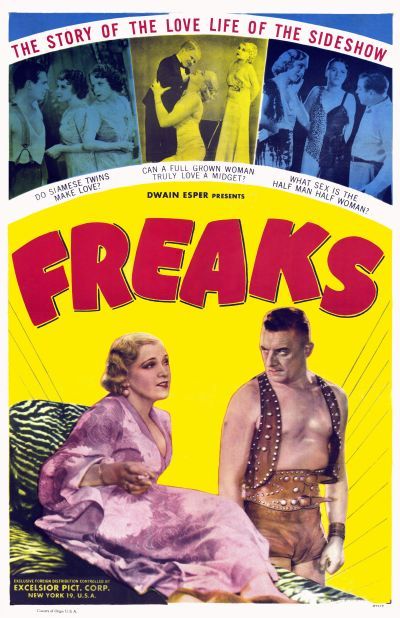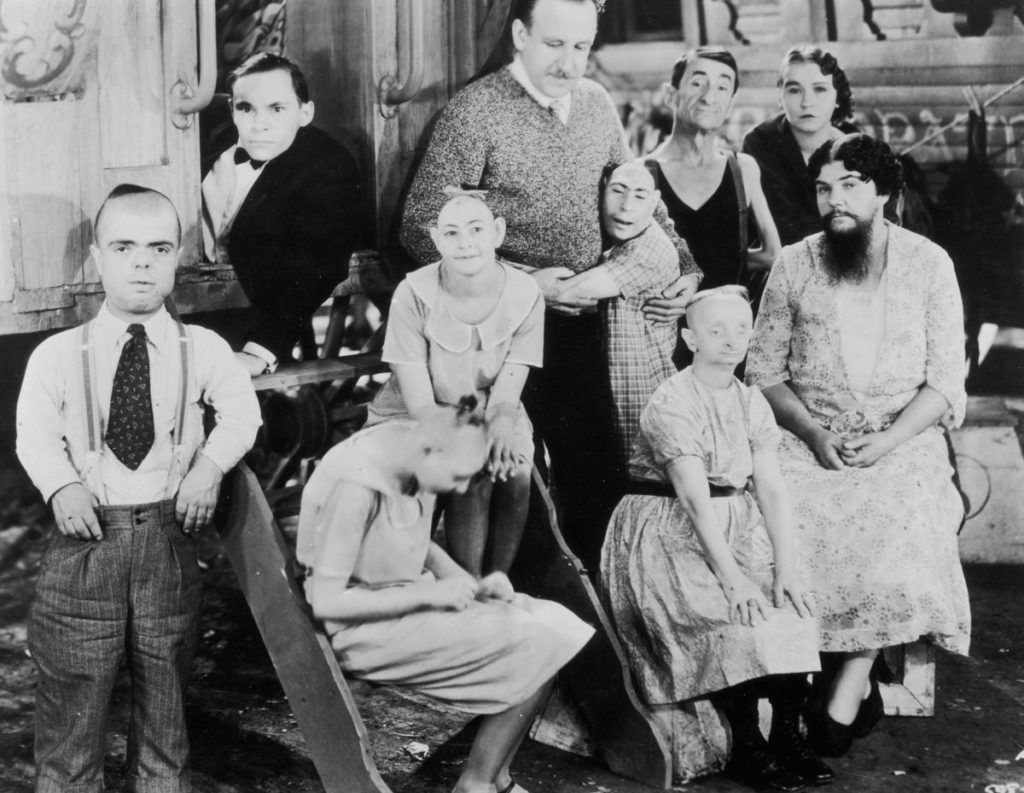
Rating: B
Dir: Tod Browning
Star: Olga Baclanova, Harry Earles, Wallace Ford, Daisy Earles
This is probably the most notorious of any pre-Hays Code film. It was met with critical ambivalence and commercial disdain on its initial release, despite the controversy surrounding the movie. Freaks was banned by British censors on its initial release, and remained that way for over thirty years. Though to be fair, it’s not clear how much effort was put into getting it released: the BBFC website notes it as “unsuitable for classification” in 1952, with nothing further until it received an X certificate in 1963. The film is now a 12A. But in many ways, there still hasn’t ever been anything like it out of mainstream Hollywood.
Even before its initial release, it was in trouble. The original version, now lost, ran 90 minutes, but test screenings provoked rapid exits and a lawsuit against MGM, by a woman who claimed watching the movie triggered a miscarriage. The studio reacted to the disastrous results by hacking the film down to less than an hour, then adding a prologue and epilogue to get it back up to feature length. It didn’t help, with audiences staying away in droves, to the point where it became the only MGM film to be pulled from theatres. Studio chief Louis B. Mayer then sold the distribution rights for 25 years to exploitation king Dwain Esper, receiving just $50,000. [Esper would exhibit the film under the titles of Forbidden Love, or Nature’s Mistakes, often along an appearance by sideshow performer Sam Alexander, who had been badly disfigured in a fire.]
 Certainly, those who disliked it at the time, hated it, as this selection of contemporary reviews cited by Wikipedia shows:
Certainly, those who disliked it at the time, hated it, as this selection of contemporary reviews cited by Wikipedia shows:
“Any one who considers this entertainment should be placed in the pathological ward in some hospital.”
“There is no excuse for this picture. It took a weak mind to produce it and it takes a strong stomach to look at it.”
An “outrageous onslaught upon the feelings, the senses, the brains and the stomachs of an audience.”
Such reactions are understandable, because the film challenges conceptions of normality which persist even now. There has been some discussion as to whether or not it is “horror”. I feel it is… but not particularly for the obvious reasons, because it’s clear Browning’s sympathies lie firmly with the freaks.
The horror stems more from the utterly cold and callous way in which trapeze artist Cleopatra (Baclanova) operates. She’s about as close to a psychopath as you’ll see out of thirties Hollywood, who exhibits no sign of genuine warmth for anyone, and is clearly only after the money carefully saved by Hans the dwarf. She has no problems manipulating others to do her will, such as circus strongman Hercules. Watching her operate is the real horror here, and there is an enormous sense of justice being served when she receives her justified comeuppance at the end. For Cleopatra is turned into what she despised most, becoming one of those for whom she showed so much disdain. It’s one of the most fitting and satisfactory endings in genre history, rarely matched.
In general, it is really the second half where things kick off. Up until the wedding feast, this is really more like melodrama on a small-scale [pun not int… Oh, who am I kidding. Pun very much intended]. The regular actors like Wallace Ford as Phroso the clown, and Leila Hyams playing an animal trainer, have more experience and it shows in their performances. Browning is wise to keep things simple for most of the real-life circus attractions, except for Hans and his equally petit fiancée, Frieda. They are played by real-life siblings Harry and Daisy Earles, originally part of a German family of four who had a long career in showbiz. And, indeed, long lives: all of the quartet lived into at least their seventies, with the last, Tiny Earles, reaching ninety before her death in 2004.
Initially, both Harry and Daisy seem to be quite stilted in their portrayals, although the century-old audio is also not at its best. But I found myself warming to both of them as the film progressed. While the dialogue delivery may still have been imperfect, the pure emotion in both of the performances, came through with absolute clarity. Frieda realizing she’s lost Hans to Cleopatra is heart-rending stuff, as is Hans at the wedding feast, seeing exactly what he has got himself into. For me, these are the points at which this tips into horror, because of Cleopatra’s needless cruelty. It’s not just the fraud, it’s her absolute and callous indifference to them as people. Weirdly, the closest parallel to her might be something like… American Psycho?

That said, the film’s climax goes back to more traditional genre tropes, in particular, fear of the “other”. Darkness, a ferocious storm and the carnies making their inexorable way to take revenge on Cleopatra. It makes for some impressively creepy visuals, such as The Living Torso (Prince Randian) wriggling his way through the mud. Let’s ignore the hard fact that you could probably escape most of them – certainly Mr. Torso – by walking away at a moderate pace. For we are thoroughly invested in seeing Cleopatra pay for her evil ways by this point, though I cannot say I felt the slightest bit of sympathy for her.
And Freaks did begat The Terror of Tiny Town, which begat The Crippled Masters, which begat Kung Fu Flid, which begat American Horror Story: Freak Show. All of them, arguably and to varying degrees, more honest in their depiction of the differently abled than many more traditional films with them as protagonists. While they are still playing roles, there’s nobody pretending here, as in the likes of blatant Oscar-bait My Left Foot. When people say a film couldn’t be made nowadays, they usually mean things like Blazing Saddles (and with dubious accuracy). But this is one of the rare examples of pre-Code cinema which is so thoroughly of its era, we will almost certainly never see its like again.
This article is part of our October 2025 feature, 31 Days of Vintage Horror.
